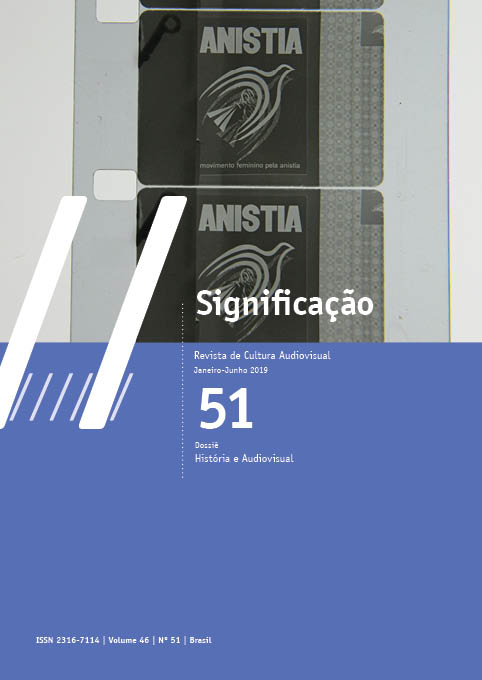Whatever happened to the melancholic queer?
DOI:
https://doi.org/10.11606/issn.2316-7114.sig.2019.144666Keywords:
artifice, Brazilian contemporary cinema, melancholia, queer cinemaAbstract
This essay aims at discussing how the presence of a queer melancholy can bring new creational possibilities. To achieve this, I intend to briefly discuss the ideas of the melancholy as lack and phantasmagoria, to then counter them with the idea of production and aestheticization, especially as brought by the Brazilian film Doce Amianto (2013), realized by Guto Parente and Uirá dos Reis. The essay argues that the melancholic queer refuses the present they live in, enabling the creation of new ways of life for the queer subject by the means of a melancholic aestheticization. Finally, I also intend to discuss how this could bring new and enriching aesthetic choices for queer films.
Downloads
References
AGAMBEN, Giorgio. Estâncias: a palavra e o fantasma na cultura ocidental. Belo Horizonte: Editora UFMG, 2007.
BARBOSA, André Antônio. Constelação da frivolidade no cinema brasileiro contemporâneo. Tese (Doutorado em Comunicação e Cultura) – Escola de Comunicação, Universidade Federal do Rio de Janeiro, Rio de Janeiro, 2017.
BENJAMIN, Walter. The Archades Project. Harvard: Harvard University Press, 2002.
CAETANO, Daniel. Doce Amianto, um filme feérico. In. Filme Cultura 61, novembro-dezembro 2013, Janeiro de 2014
DELEUZE, Gilles; GUATTARI, Félix O anti-édipo: capitalismo e esquizofrenia. São Paulo: Ed. 34, 2010.
DUGGAN, Lisa. The Twilight of Equality?: Neoliberalism, Cultural Politics, and the Attack on Democracy. 1st ed. Boston: Beacon Press, 2003.
FREEMAN, Elizabeth. Time Binds: Queer Temporalities, Queer Histories. Durham: Duke University Press, 2010.
FREUD, Sigmund. Mourning and Melancholia. IN: The Standard Edition of the complete works of Sigmund Freud. London, Hogarth Press: Institute of Psycho-analysis, 1953-1974. Vol. 14, pp. 243-258, 1955.
GALT, Rosalind. Pretty: Film and the decorative image. Nova York: Columbia University Press, 2011.
HALBERSTAM, Jack. The queer art of failure. Durham and London: Duke University Press, 2011.
HALPERIN, David M. How to be gay. Cambridge, MA: Belknap Press of Harvard University Press, 2012.
HOLLERAN, Andrew. Dancer from the dance. Nova York: HarperCollins, 2001.
LOPES, Denilson. O retorno do artifício no cinema brasileiro. In: SOBRINHO, Gilberto Alexandre (Org). Cinema em redes: tecnologia, estética e política na era digital. 2016.
______. Nós, os mortos: melancolia e neobarroco. Rio de Janeiro: Sette Letras, 1999.
LOVE, Heather. Feeling Backward: Loss and the Politics of Queer History. Cambridge, Mass: Harvard University Press, 2007.
Downloads
Published
Issue
Section
License
Copyright (c) 2019 Ricardo Duarte Filho

This work is licensed under a Creative Commons Attribution-NonCommercial 4.0 International License.
Authors who publish in this journal must agree with the following terms:
- Authors keep their copyrights and grant the journal first time publication rights, having their articles simultaneously licensed under the Creative Commons Attribution License, which allows sharing texts with authorship recognition and first publication on this journal for non-commercial purposes.
- Authors are allowed to make additional contracts, for a non-exclusive distribution of the article’s version published on this journal (e.g.: publishing in institutional repositories of articles or as a book chapter), with authorship recognition and first publication on this journal.
















